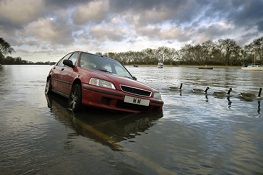 A storm that recently pummeled several states in the Midwest has sparked an advisory from the AAA in Oklahoma, where the motoring group says used-car shoppers should be cautious.
A storm that recently pummeled several states in the Midwest has sparked an advisory from the AAA in Oklahoma, where the motoring group says used-car shoppers should be cautious.
A flood-damaged car is worth substantially less than other vehicles sold as used, so any unscrupulous salesman might conveniently forget a car’s history when you come calling to buy.
After wild weather hit neighboring states like Kansas, the AAA says, Oklahomans might see more cars with a shaky history hitting their used-car market soon — the trick is being able to spot one.
How They Get to the Used Car Lot
Much of a car’s post-crash future depends on its “fair market value” that is determined by a car insurer.
Repairs costing more than a vehicle’s “fair market value” means it’ll be junked with the total-loss label.
Insurers will then sell total-loss vehicles to salvagers who should disassemble parts for sale.
And this is the part of the process that is dangerous for consumers: shady car-buyers scope out salvage yards for quick-buck purchases. Even though the cars are restored and are operable, the “varying levels of expertise” by these car-buyers often leave consumers with the short end of the stick, according to the AAA.
How to Spot Them
Even with all the vehicle history reports available for free to consumers — from a popular one at CARFAX to another provided by the National Insurance Crime Bureau (NICB) — they aren’t a guarantee that you’ll know the entire backstory of that beloved buy you’ve just spotted.
According to the AAA, a CARFAX Vehicle History report will “potentially” show whether or not a vehicle has been involved in a major crash, flood, or fire.
Here’s the rub: “Incidents are occasionally not reported officially,” says the AAA.
So what’s a consumer to do? A good nose and sharp eye will help spot telltale signs that a vehicle has been through tough times.
The AAA offered a number of tips for Oklahomans hoping to dodge buying that car they didn’t know was flooded:
Corrosion: Growth of corrosion on a car is a giveaway that the car might have had a history of being flooded. AAA suggests looking under the vehicle and around the vehicle’s doors, hood and trunk for signs of corrosion. “Pay special attention to small spaces and crevices that are difficult to clean,” says AAA.
Odors/Dirt: AAA says to “engage your sense of smell” for dampness or mustiness in the car. Even if a seller tried to shampoo the car’s interior to get a lemon past you, you might be able to find “mud, dirt, or signs of water stains” if you pull back different parts of the car’s carpets. The “underside of the dashboard” is another spot a curious consumer can find evidence that a used car has been severely damaged in the past.
Electrical Parts: Flooding will undoubtedly destroy a car’s electrical parts, so any wonky warning lights and window motors will tip you that something’s amiss. “While a non-working part alone does not mean the vehicle was flooded, it combined with other difficulties is a cause for concern,” says AAA.
History/Research: Just because vehicle history reports aren’t fool-proof doesn’t mean they aren’t useful.
Checking any one of the free reports (usually requiring just a vehicle identification or license plate number) might be the easiest way to know right off the bat if your prospective car purchase is on the level. Still not sure? Any one of the AAA’s “quality repair facilities” can inspect the car for you (a listing of locations available here).
They’re Not Just in Oklahoma
The same type of advisory was distributed after floods and other inclement weather brought by Superstorm Sandy damaged hundreds of thousands of vehicles in New Jersey and New York.
The NICB joined with authorities in the same way they did following Hurricane Katrina, cross-referencing police and claims reports to log salvage and damage history into federal databases, as well as its own. The bureau warned consumers that minimally-repaired, post-Sandy lemons could end up on used car lots around the U.S.
Even consumers in Maine should be wary. In March, Eric Cioppa, the state’s insurance superintendent, issued an advisory about such vehicles that “could be for sale in Maine right now.”
To hide car damage and records of it, Cioppa said, car sellers engage in “title washing” in which they move a car and its title to other states.
“Severely damaged vehicles may appear for sale in Maine without any indication that they were affected by Sandy,” he said in a statement. “Even new cars could have sustained flood damage.”
What Coverage Takes Care of a Flooded Car?
Comprehensive coverage takes care of water damage and other weather-driven events that can harm your vehicle like hail and falling trees.
About 3 out of every 4 policyholders has that coverage, according to the Insurance Information Institute. It is one of the more valuable forms of coverage when considering the incidents it protects against, including car theft and fire.